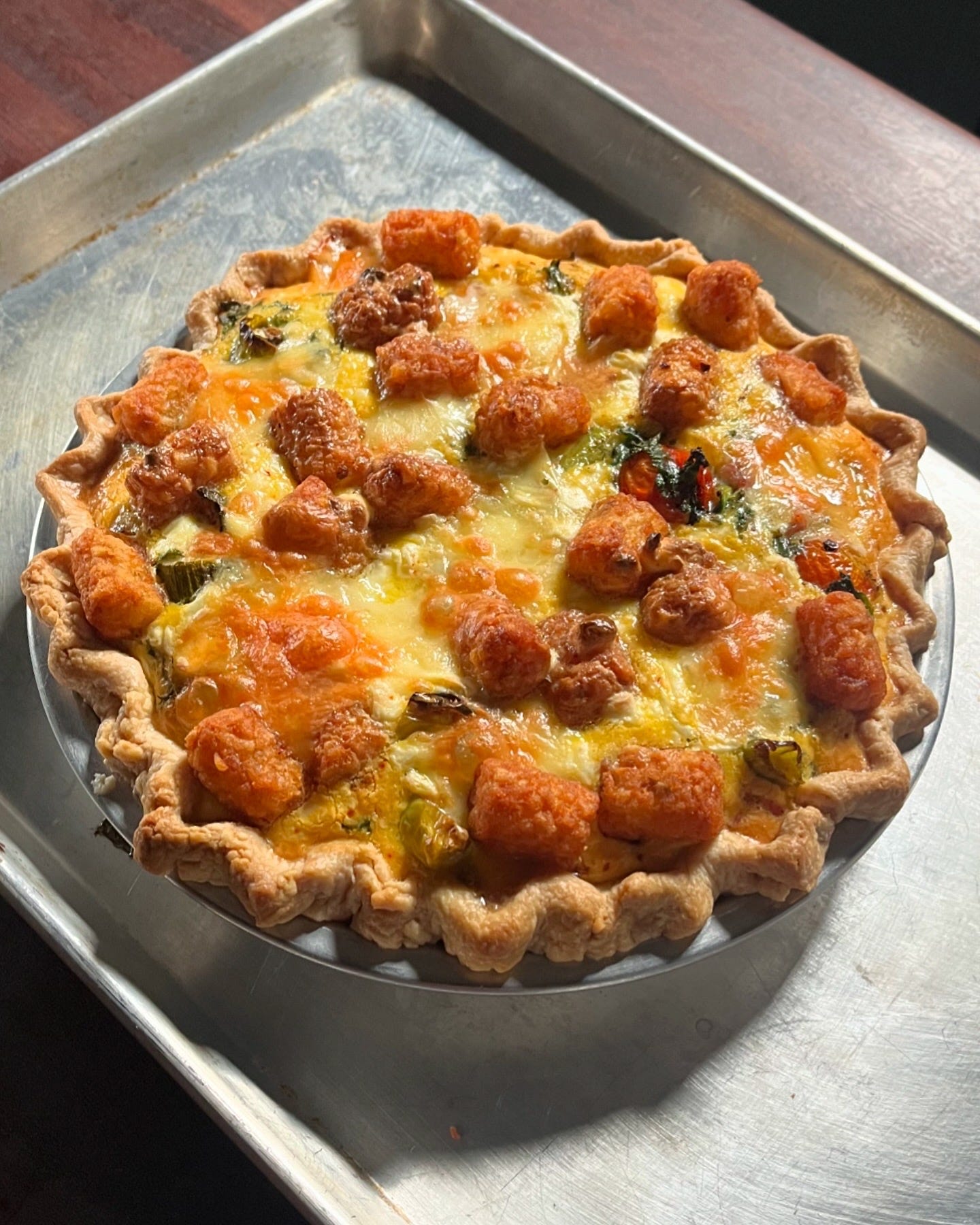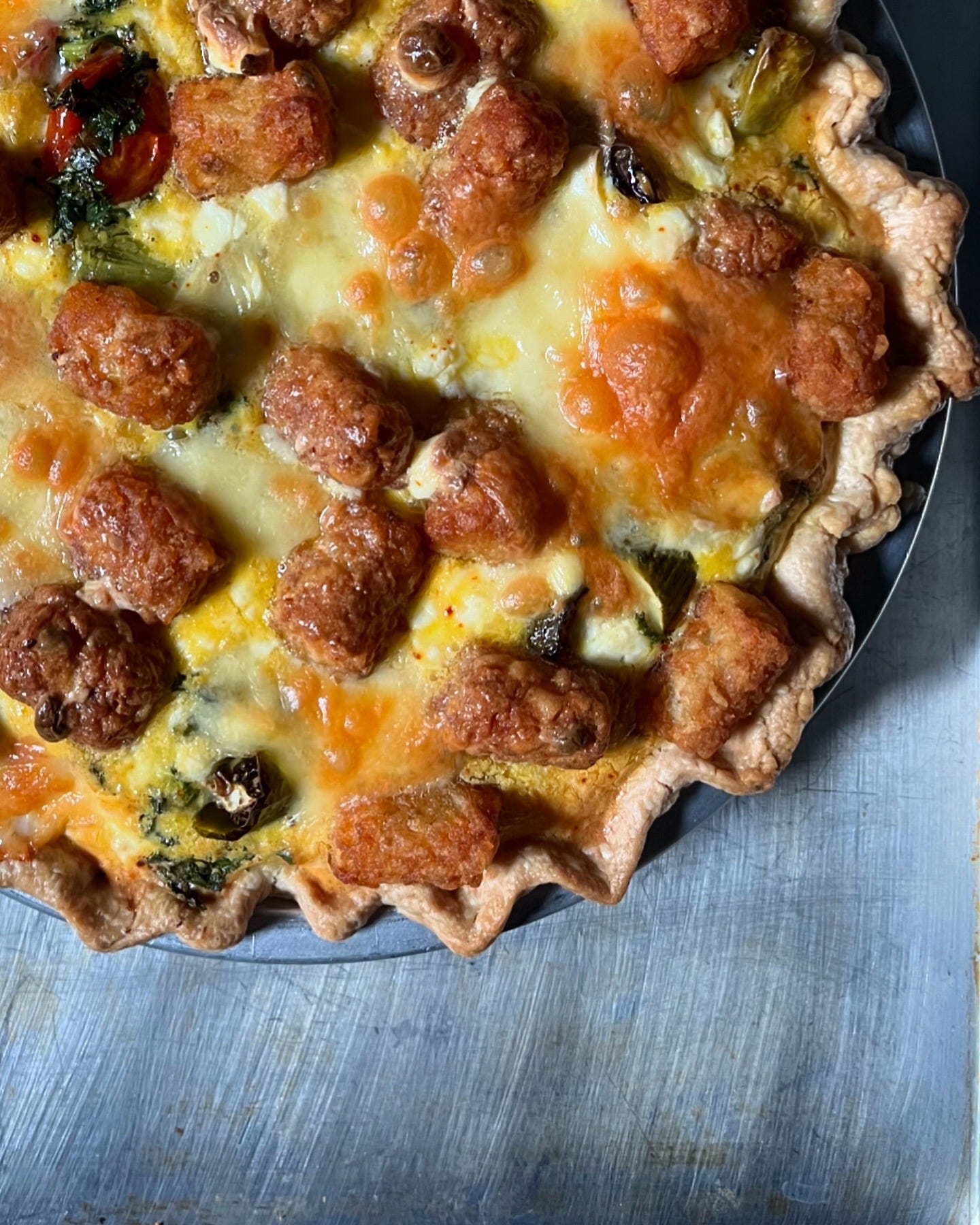I wasn’t planning to write this recipe up, but I had an unexpectedly enthusiastic response to my hotdish-inspired quiche when I posted about it last week, so here we are. I did learn that tater tots are tragically unavailable in the UK - the following method can be applied to any sort of quiche. In fact, its less a recipe, and more a set of ideas for you to riff on. I make both quiche and frittatas regularly and I never measure the ingredients, nor do I think you really have to, if you’ve mastered a few basic tips.
A quick note:
Many of you have already seen the devastation wrought by Hurricane Helene in North Carolina, Tennessee, Florida, and Georgia. Southern Smoke Foundation is set to provide grants to hospitality workers in affected areas, and Blue Ridge Public Radio has put together a list of other ways to help. Please consider donating if you are able.
A Tater Tot Quiche is Born
Lately, I have been working hard to become the woman I want to be: a woman who uses up every scrap of leftovers in her fridge. I could tell you this is my noble effort towards sustainability, but truthfully, I think it’s looming middle age: I currently count cleaning and organizing my refrigerator as one of my more exhilarating weekly hobbies. After every grocery trip, I pull a chair up to my fridge and detail it, FIFOing1 yogurt and parmesan, rotating lettuce in the crisper, and figuring out how to incorporate any remaining leftovers into tomorrow’s lunch.
Thus, tater tot quiche was born. I had an excess of eggs, a dash of cream, leftover grilled zucchini and tomatoes, a pallid quart of shredded kale, a freezer-burnt roll of store-bought pie crust, three slices of salami, and half a bag of tater tots. A couple of pieces of cheddar rounded out my plan.
Last year, I published an essay on how to improvise a savory galette, where I wrote the following:
Learning where and how to riff in a recipe is a great way to liven up your baking, and a galette is a great place to start since, no matter, what, we’re all just chucking a temperamental range of ingredients in a flaky crust and hoping for the best. In my opinion, even a galette you’ve made a million times will always come out a little bit different depending on the vagrancies of the oven, the ripeness of the fruit or veg, the phase of the moon.
The same, I believe, is true for quiche. I don’t quite have a recipe for you today, but I also don’t really think you need one. Sure, I could iterate a tater tot quiche twenty times in a row and build out a recipe that answers any conceivable question, but a tater tot quiche is just not that serious. Instead, I’ll walk you through my thought process for assembling this quiche, so that you, too, can chuck all of your leftovers in a crust, cover it with eggy custard, and enjoy a lunch flavored with a little sanctimonious glee.
The crust
I don’t think you need to be precious here, and I’ve already revealed myself to be the sort of person who has store-bought pie crust in the freezer. I think it can be a nice thing to have around if you don’t feel like making one from scratch, and while they may not be as delicious as homemade, they make a perfectly adequate vehicle for quiche. Or, make your own, from whatever recipe you like. The most important thing here is that we’ll need to blind bake the crust. I like to parbake mine a little harder than you might expect, since my egg custard won’t take long to set up (more on that later). I weigh my crust down with a sling of parchment and some old brown rice, and bake it in a preheated 375 degree oven for twenty minutes. When done, you should see the bottom of the crust has lost its damp sheen, and your crimped edge will be a pale golden brown. This may take more or less time in your oven.
The filling
While your crust is parbaking, we’ll figure out our filling. We want all of the vegetables that go into our quiche to be pre-cooked and well-seasoned. This means any juicy vegetables, like peppers or summer squash, will need a hard sear to draw out and evaporate excess water. Cherry tomatoes, if used, should be roasted until burst and caramelized. I’m not a fan of patches of watery veg in my quiche custard, so taking these steps will mitigate that.
Make sure you’re seasoning as you go, a key to building flavor. I use salt and pepper or these korean chili flakes. Of course, leftover grilled or roasted veg is great for this purpose as it’s already pre-cooked. If you’re using greens, saute them with lots of garlic, salt, and pepper, and add a little more than you think you’ll need to the pan, as well all know they’ll shrink down more than we expect. I want my quiche to be chock-full of filling, just barely bound together with custard. If you’re using meat, like salami or bacon, chop it up into small bits and treat it like a seasoning.
Here is an incomplete list of further leftovers that I think would be tasty in a quiche:
Mashed potatoes (I would ball these up into croquette-sized pieces and scatter them around the bottom of the crust)
Croutons (think savory bread pudding)
Old slightly sad bags of spinach or arugula
Leftover charcuterie
A wilted salad of bitter, hearty greens
Roasted sweet potatoes or hash browns
Knobs of dried-out parmesan, grated
Bits of stale biscuits, savory scones, or cornbread
The last of a jar of kimchi or salsa
Whatever you use, you’ll want about three cups of filling for a 9” quiche.
The custard
I need a synonym for the phrase “don’t be too precious about it” so that I can say it again. I use 5-6 eggs, beaten well with a pinch of salt, pepper and about half a cup cream. This may be a pastry chef problem but I always have cream laying around that needs using up. You could also use half-and-half. I personally would not use milk as I find that eggs take on a sulfurous quality I don’t enjoy when not muted with a healthy dollop of fat. Your custard will be much silkier for it as well, and will set firmly in a shorter amount of time. I also use the custard as an opportunity to use up the dregs of any other dairy products I have laying around - the last scraping of a tub of sour cream, labne, or ricotta, for instance. I never measure that element but I’d hazard you shouldn’t add more than 3/4 of a cup.
The tots
If you have them, cook them first. I have an air fryer, so I use that. They should be as I crispy as you can make them. I think I used roughly 16 tater tots for my own quiche.
I think sometimes people are surprised I have processed food laying around. I don’t think processed food is inherently bad, and our pantry is stocked with lots of both raw ingredients and convenience foods. This frees up mental space for me to think about things other than making all my meals from scratch. Processed foods are a gift.
To assemble and bake
Place your filling in your pie shell - it should fill it up about three-quarters of the way. Pour your egg custard over the filling. It might seem like too much custard but it will all soak in. If using tots, press them onto the surface of the quiche - some will eventually be submerged and lend a spanish-tortilla quality once baked. If you’re using a melty cheese, or a crumbly feta or bleu, scatter it over the surface of the quiche now. Bake in your oven until set, which might be 20 minutes, or maybe more like 35. I didn’t measure the amount of time it took my own quiche to bake, and this isn’t a real recipe anyway. This is a nice time to sharpen our powers of observation: your cheese should be melty and your crust golden when the quiche is finished, and your egg custard should be firm but not rubbery. A little undulating wiggle in the center is fine. I let mine cool most the way before slicing and serve it gently warm.
First In, First Out, the process of rotating new goods behind the old that is familiar to anyone who has put a delivery away in a commercial walk-in cooler.







Love this recipe. Blizzarely, you can get Marco Pierre White branded tater tots in the UK but only wholesale to the hospitality industry. The nearest equivalent in the supermarket are mini frozen hash browns. Or you could just chop up some normal sized hash browns.